|
|
 |
Grace O'Malley
Active 1560's - 1580's |
This Irish noblewoman led attacks on shipping off the West coast of Ireland. In 1593 she won a pardon and a pension from Queen Elizabeth I. She then retired, handing over her business to her sons. |
John Oxenham |
First English captain to sail the Pacific. In 1572, Oxenham took part
on the raid in Panama which was headed by Sir Francis Drake.
In 1573 Oxenham was second in command, still under Sir Francis Drake, during the march to Panama.
According to reports, Drake climbed a tree and saw the Pacific Ocean whereby he vowed: "besought
Almighty God of his goodness to give him life and leave to sail once in an English ship on that sea"
At which Oxenham seconded: "protested that unless our Captain did beat him from his company he would
follow him by Gods grace." During the raid, Drake and Oxenham split forces and tried two different
approaches to Panama. Oxenham returned before Drake and set sail with two ships and 57 men, including
John Butler.
Oxenham made his way to the Atlantic coast to prey on shipping. He spent the winters of 1576-1577
inland. In February 1577, Oxenham (in a pinnace which his men and some escaped African slaves, the
Cimarrónes built) via a river entered the Gulf of Panama. They looted the Pearl Islands where they
tortured a Franciscan friar. From there they plundered two ships laden with gold and silver headed
for Panama. Leaving the Pacific, they were headed towards the Atlantic when they were attacked by
the Spanish. Many of Oxenham's men were killed and the treasure was recaptured. Oxenham and some
of his men escaped but were hunted down, captured and taken to Panama in April 1578. A total of
18 Englishmen and 40 Africans. 14 of the Englishmen were hanged, the Africans were returned to
slavery and Oxenham, Butler and Thomas Sherwell (all of whom were officers) were taken to Lima,
Peru and executed late 1580. |
  |
William Parker |
Captain William Parker was a member of the lesser gentry near Plymouth.
In 1587 he sailed in consort with Sir Francis Drake during Drake's raid on Cadiz, Spain.
In the 1590's Captain Parker sailed the West Indies taking several prizes. He also plundered Puerto
Caballos in Honduras in 1594 and 1595. After 1596, as owner of his own vessel, he partnered with
Sir Anthony Sherley, but this relationship ended when after a time no prizes were taken.
Leaving Captain Sherley behind, Captain Parker attacked Campeche, Mexico. Captain Parker was wounded
in the attack but survived and succeeded in capturing a frigate carrying silver which was en route
to San Juan De Ulua.
Captain Parker next captured Portobello in February 1601. Portobello was a very important port
being the departure point from which Peruvian treasure left for Spain. Captain Parker then sailed
to Panama and plundered Saint Vincent in the Cape Verdes. He also captured and held for ransom the
Cubagua pearl-boats and captured a Portuguese slave ship. His successes secured for him a prominent
position in Plymouth, where he was looked upon as a hero of sorts and he became a founding member
of the Virginia Company in 1606.
Captain Parker was made Vice-Admiral and left on an expedition to the East Indies, but died at
Java in 1617. |
Elizabetha Patrickson
Circa 1634 |
|
James Plantain
Active 1720's |
Born in Jamaica, this pirate set up his base on Madagascar. He built a
fortress at Ranter bay and declared himself 'King'. He kept many wives and was said to live
in luxury. |
el Portugués
AKA Bartolomeo
Portuguese Buccaneer
Active 1660's - 1670's
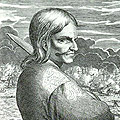 |
Famous for his lucky escapes,
this Portuguese buccaneer was one of the first to be based in Jamaica. His luck finally ran out
in a shipwreck. |
Lawrence Prince
Dutch Pirate
Active 1670 |
Captain Prince was born in Amsterdam. In 1670, he sailed from Port Royal,
Jamaica to Colombia. He had plans to take the town of Mompos which was over 150 miles inland, part
of the trip was up the Magdalena River. Upon their arrival they found a new fort on an island river.
The pirates were drove back with cannon fire. Captain Prince was determined not to return to Port
Royal empty handed. In August he sailed for Nicaragua and was successful in an almost identical
scheme. He sailed up the San Juan River, captured the fort and took canoes up to Lake Nicaragua
where they pillaged the city of Granada.
The Spanish report of the incident states, made havoc and a thousand destructions, sending the
head of a priest in a basket and saying that he would deal with the rest of the prisoners in the
same way unless they gave him 70,000 pesos in ransom.
Considering that the city had been sacked by Captain Henry Morgan and Captain John Morris in 1664
they were only able to raise a small portion of the ransom. prince having his bluff called, returned
to Port Royal.
Modyford, Governor of Jamaica, sent Captain Prince to join Morgan's Panamanian expedition. Morgan,
seeing Prince to be a man of much spirit, made him third in command after himself and
Captain Edward Collie. After the raid, the English government sent Thomas Lynch to Jamaica to
arrest Modyford and Morgan for their piratical activities. Lynch, not having sufficient force to
outright arrest Sir Henry Morgan, decided to try ingratiating himself to the pirates.
Captain Prince was made Lynch's lieutenant and under the governorship of Lynch thrived at Jamaica,
having his own plantation. |
  |
Jack Quelch
Circa 1700's |
At Half Way Rock, outside of Salem Harbor, Jack Quelch was named
captain of the vessel "Charles" after its crew had murdered and dumped overboard its previous
commander. From there he led his band of pirates in raids off the coast of South America.
Their piracy days ended when Captain Quelch and his crew were arrested and hanged in 1704 at Boston Harbor. |
  |
John Rackam
AKA Calico Jack
British Pirate
Died 1720
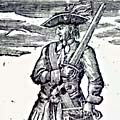 |
John Rackam was nicknamed Calico Jack by many due to his fondness for wearing
calico colored coats and britches. He is best known for his association with Anne Bonny
and Mary Read, the most famous female pirates.
Rackam acquired command of his ship the Treasure when the former Captain Vane retreated from an
attack of a French man-of-war. The crews' feeling that this was an act of cowardice along with Rackam's
zealous protests were the behind Vane's loss of command. The crew then
captured the man-of-war and the former quartermaster of Vane's vessel, became its captain, and Vane was
cast off on a smaller sloop along with the members of the crew who had voted against Rackam.
Eventually, Rackam turned over control of his ship to the two female pirates Mary Read and Anne Bonny,
the latter of which he had whisked away willingly from her husband, and who had fought at his side in
many a battle. His ship was captured in November 1720, and brought to Jamaica. Nearly the entire crew,
including Rackam himself were sentenced to hang. "If he had fought
like a man," said Anne, "he need not have been hanged like a dog."
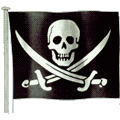
|
Raga
Active 1820's |
Chief of the Malay pirates in the Straits of Makassar, Raga took many European
ships and beheaded their crews. His base at Kuala Batu, Sumatra, was destroyed by an American task force. |
Rahmah bin Jabr
c. 1756 - 1826 |
The most famous pirate of the Persian Gulf, this one-eyed captain plundered
shipping for 50 years. At the age of 70, in battle with the whole fleet of Bahrain, he set fire to the
gunpowder magazine on his own ship, blowing half the enemy and himself sky high. |
Sir Walter Raleigh
1552 - 1618 |
An Elizabethan courtier and navigator, Raleigh fitted out many privateering
expeditions in order to fund a new colony in Virginia, North America. On the death of Queen Elizabeth I,
Raleigh's fortunes changed. In 1616 he persuaded James I to send him on another search for gold, but
he returned empty handed and was beheaded. |
Mary Read
British Pirate
Active 1719 - 1721
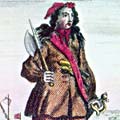 |
Dressed in men's clothes, Mary Read had fought as a soldier in Flanders and owned a tavern before sailing to the Caribbean. When her ship
was captured by John "Calico Jack" Rackam and Ann Bonny, she joined their pirate crew.
Captured in 1720, a female passenger on the merchant ship they had attacked noticed
Read's breasts and figured out she was a woman. At her trial in 1720, like Bonny,
Read escaped the gallows because she was expecting a baby. She died of fever in Jamaica in 1721. |
Redbeard
AKA Barbarossa
Greek/Turkish Pirate
circa 1530's |
He and his brother Aruj, sons of a Turk from Lesbos,
took up piracy on the Barbary Coast in hopes of seizing an African domain for themselves.
When Aruj was killed in 1518, Khidr took the title Khayr al-Din.
He offered allegiance to the Ottoman sultan and in return received
military aid that enabled him to capture Algiers in 1529. Appointed
admiral in chief of the Ottoman Empire (1533), he conquered all of Tunisia.
Emperor Charles V captured Tunis in 1535, but Khayr al-Din defeated his fleet
at the Battle of Preveza (1538), securing the eastern Mediterranean for the
Turks for 33 years. His red beard was the source of the epithet Barbarossa, used by Europeans. (Excerpt from Britannica Online) |
Basil Ringrose
active 1653 - 1686 |
This English surgeon traveled through Panama with Bartholomew Sharp and his
buccaneers between 1680 and 1682, and wrote about his travels. He was killed in Mexico. |
Manuel Pardal Rivero
Portuguese Pirate |
Spain, a long time victim of pirating, suffering heavy losses from the
pirates and deciding that Sir Henry Morgan's Portobello raid in 1669 was the last straw, sanctioned
the governors of its colonies in the procurement of privateers and disbursement of letters of marque.
Few pirates responded to this act, but Captain Rivero, who was Portuguese, did and rushed out to seek
enemy nation's ships to prey upon.
In 1670, Rivero, in command of the San Pedro left Cartagena for Jamaica but was forced to change
course because of winds. Captain Rivero sacked the poor settlement on Grand Cayman Island and seized
two small boats as well as taking four children. With his meager booty, he went to Cuba. Once there
he found out that Bernard Speirdyke, the Dutch pirate, was at Manzanillo. Captain Rivero set out to do
battle with Speirdyke. Captain Rivero was victorious in the battle and seized the Dutchman's ship.
Captain Rivero returned to a hero's welcome in Cartagena in March 1670 and was made admiral of the
Spanish corsairs. Captain Rivero next went to Jamaica with two ships and captured a sloop and raided
isolated villages in the north. His next venture took him to the southern coast of Jamaica where he
issued a challenge to Captain Henry Morgan:
Governor Modyford of Jamaica commissioned Captain Morgan to defend Jamaica. Captain Morgan assembled
all French and English pirates that were at Jamaica and set sail, but instead of looking for
Captain Rivero, they sailed to Panama and sacked the town. While all this was going on, John Morris
encountered Captain Rivero off the Cuban coast. Captain Rivero's ship was boarded by Captain Morris
men. The crew panicked and jumped overboard, where they either drowned or were shot by Morris' men.
Captain Morgan chased Captain Rivero ashore and shot him to death in 1670. |
Bartholomew Roberts
AKA Black Bart
Welsh Pirate
1682 - 1722
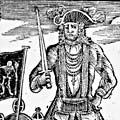 |
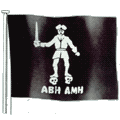 Roberts was known for his excellent seamanship
and was one of the greatest pirates of his day.
Roberts is said to have seized 400 ships off West Africa
and in the Caribbean. His biggest coup was capturing the "Sagrada Familia," a Portuguese
vessel carrying a fortune in coins, diamonds and goods from Brazil. Captain Roberts was killed was killed by a blast of grapeshot from H.M.S. Swallow on February 10, 1722. His body was buried at sea by his crew and was never found.
(See Thomas Anstis and Walter Kennedy)
Roberts was known for his excellent seamanship
and was one of the greatest pirates of his day.
Roberts is said to have seized 400 ships off West Africa
and in the Caribbean. His biggest coup was capturing the "Sagrada Familia," a Portuguese
vessel carrying a fortune in coins, diamonds and goods from Brazil. Captain Roberts was killed was killed by a blast of grapeshot from H.M.S. Swallow on February 10, 1722. His body was buried at sea by his crew and was never found.
(See Thomas Anstis and Walter Kennedy)
Books on Roberts:
|
Woodes Rogers
English privateer
1679 - 1732 |
Rogers was a Privateer who helped suppress
piracy in the Caribbean by offering caught pirates pardons if they changed their ways and
helped him track down other pirates. Those who did not accept or who went back to their old ways
were hanged. While on a privateering expedition around the world
which was commissioned by Bristol merchants whose ships had been lost to foreign privateers,
he rescued a Scottish seaman named Alexander Selkirk from a Pacific island, which inspired Defoe's
book Robinson Crusoe. In 1717 Rogers was appointed royal governor of the Bahamas where he established
orderly government. |
 |


